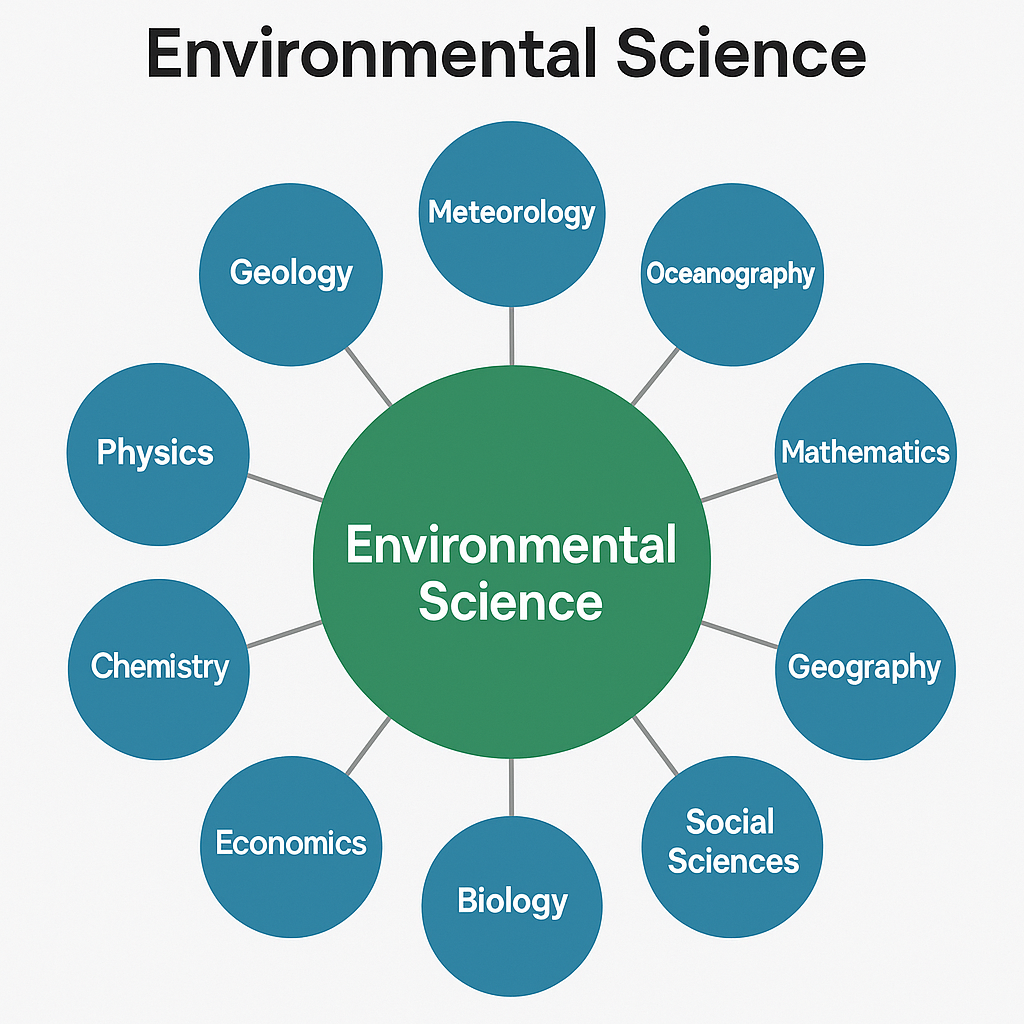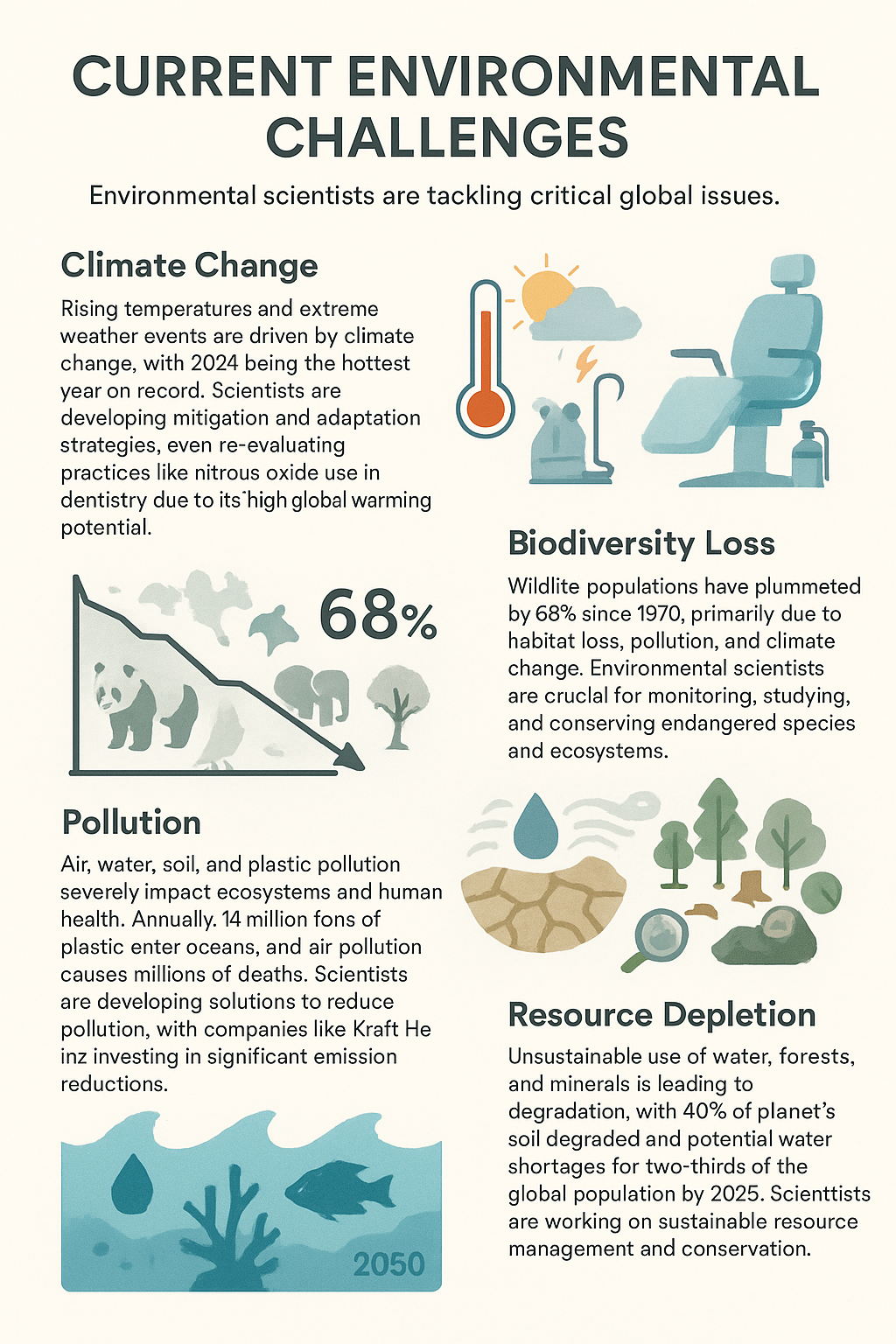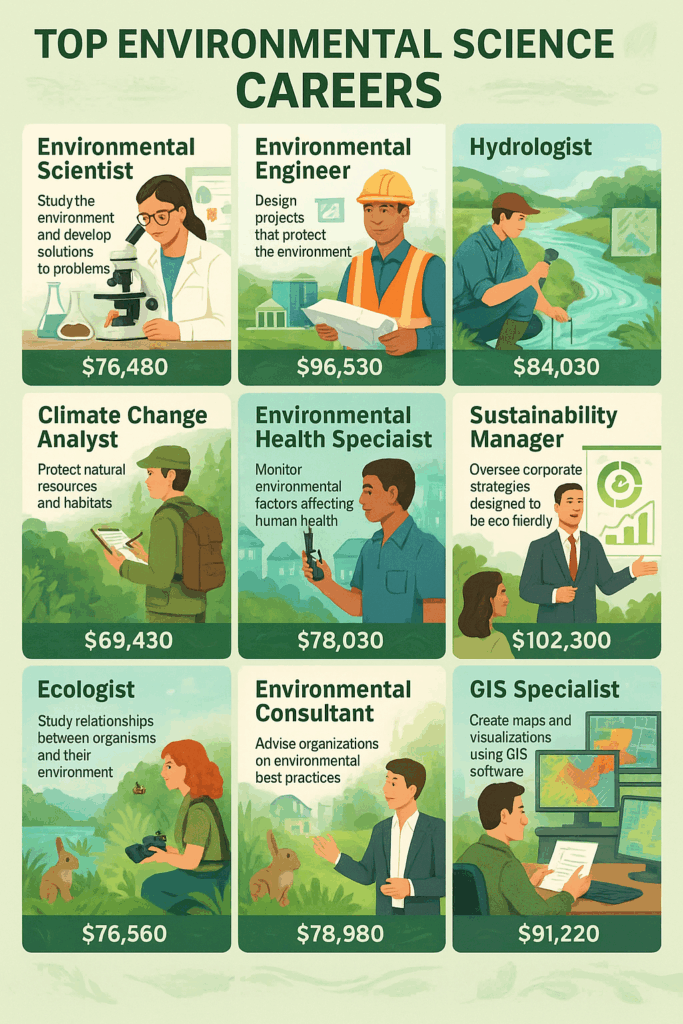What is Environmental Science? A Comprehensive Guide to This Vital Field

Introduction: The Science That Shapes Our Future
Plot twist: Environmental science isn’t just about studying trees and recycling. Recent Stanford research found that environmental scientists are now among the most sought-after professionals in the job market, with a projected 7% growth rate through 2033—significantly outpacing the average for all occupations. While most people still think of environmental science as a niche field, the data reveals something fascinating about its expanding role in addressing our planet’s most pressing challenges.
Environmental science has evolved from a specialized discipline into a critical framework for understanding and solving complex global issues. As we navigate the challenges of climate change, biodiversity loss, and resource depletion, the need for environmental expertise has never been more urgent. This comprehensive guide explores what environmental science is, why it matters, and how it’s shaping our collective future.
What Is Environmental Science?
Environmental science is an interdisciplinary academic field that integrates physical, biological, and information sciences to study the environment and develop solutions to environmental problems. Unlike environmentalism, which is a social movement focused on protecting the natural world, environmental science is a scientific discipline that uses evidence-based approaches to understand environmental systems and address environmental challenges.
According to the National Science Foundation, environmental science emerged as a distinct field during the environmental movement of the 1960s and 1970s, though its roots extend back to the Enlightenment period when natural historians began systematically studying the natural world. Today, it has developed into a sophisticated discipline that combines elements from numerous scientific fields.
As our deep dive into scientific methodologies previously revealed, environmental science applies rigorous research methods to understand complex ecological relationships and human impacts on natural systems.
The Interdisciplinary Nature of Environmental Science
What makes environmental science unique is its inherently interdisciplinary approach. Unlike traditional scientific disciplines that focus on a single aspect of the natural world, environmental science draws from multiple fields to create a more comprehensive understanding of environmental systems.
The major disciplines that contribute to environmental science include:
- Biology and Ecology: Studies living organisms and their interactions with each other and their environment
- Chemistry: Examines the chemical composition and processes in air, water, and soil
- Physics: Investigates energy flows and physical processes in environmental systems
- Geology: Studies Earth’s physical structure, substances, history, and processes
- Meteorology: Focuses on atmospheric conditions and weather patterns
- Oceanography: Explores marine environments and processes
- Mathematics: Provides tools for modeling and analyzing environmental data
- Geography: Examines spatial relationships and human-environment interactions
- Social Sciences: Considers human behavior and policy aspects of environmental issues
- Economics: Analyzes resource allocation and the economic impacts of environmental decisions
This integration of disciplines allows environmental scientists to address complex problems that cannot be solved through a single scientific lens. For example, understanding climate change requires knowledge of atmospheric physics, ocean chemistry, biological carbon cycles, and human economic activities.
As noted in our article on science denial, this interdisciplinary approach is crucial for developing comprehensive solutions to environmental challenges that some still refuse to acknowledge despite overwhelming evidence.
Major Branches of Environmental Science
Environmental science encompasses several specialized branches, each focusing on different aspects of the environment:
1. Atmospheric Science
Atmospheric science studies the Earth’s atmosphere, including air quality, climate patterns, and weather phenomena. The scientists investigate greenhouse gas emissions, air pollution, and their impacts on climate and human health.
The University of Michigan research reveals that around 14.8% of Americans still deny climate change, even as hurricanes intensify and heatwaves become more frequent—highlighting the importance of atmospheric science in providing concrete evidence of climate change impacts.
2. Ecology
Ecology examines the relationships between organisms and their environment. This branch studies ecosystems, biodiversity, population dynamics, and the impacts of human activities on natural communities.
According to a 2020 WWF report, wildlife populations have declined by an average of 68% between 1970 and 2016, primarily due to habitat loss and environmental degradation—making ecological research increasingly vital for conservation efforts.
3. Environmental Chemistry
Environmental chemistry investigates the chemical processes occurring in the environment and how pollutants interact with air, water, and soil. This field is crucial for understanding contamination, developing remediation techniques, and assessing toxicity risks.
Recent studies on biofluorescent mammals have revealed how chemical compounds in animal fur can interact with UV light, demonstrating the fascinating chemical processes that occur naturally in the environment.
4. Environmental Geology
Environmental geology focuses on how geological processes affect human activities and how humans impact geological systems. This includes studying natural hazards, resource management, and land use planning.
The rare discovery of tantalum in river sand in India demonstrates how geological research can reshape resource landscapes and potentially lead to greater self-sufficiency in critical minerals.
5. Environmental Biology
Environmental biology examines how living organisms adapt to and are affected by their environment. This includes studying biodiversity, conservation, and the impacts of environmental changes on species and ecosystems.
Recent research on human evolution has shown how climate changes influenced the fusion of ancestral populations, highlighting the profound impact of environmental factors on biological development.
6. Environmental Policy and Management
This branch focuses on developing and implementing policies and management strategies to address environmental issues. It bridges the gap between scientific knowledge and practical action, incorporating aspects of law, economics, and public administration.
Current Environmental Challenges
Environmental scientists are at the forefront of addressing some of the most pressing challenges facing our planet today:
1. Climate Change
The most significant environmental challenge of our time, climate change is causing rising temperatures, sea level rise, and more frequent extreme weather events. According to Earth.org, 2024 was confirmed as the hottest year in history, with global average temperatures 1.60°C above pre-industrial levels.
Environmental scientists study climate patterns, develop models to predict future changes, and work on mitigation and adaptation strategies. As our analysis of nitrous oxide use in dentistry noted, even medical practices are being reconsidered due to their climate impacts, as nitrous oxide has 298 times the global warming potential of carbon dioxide.
2. Biodiversity Loss
The rapid decline in biodiversity threatens ecosystem stability and resilience. The WWF reports that wildlife populations have declined by 68% since 1970, with habitat loss, pollution, and climate change as major drivers.
Environmental scientists monitor biodiversity, study endangered species, and develop conservation strategies to protect vulnerable ecosystems. Their work is essential for preserving the planet’s biological diversity and the ecosystem services it provides.
3. Pollution
Various forms of pollution—air, water, soil, and plastic—continue to harm ecosystems and human health. Earth.org reports that approximately 14 million tons of plastic enter the oceans annually, while air pollution causes 4.2 to 7 million deaths worldwide each year.
Environmental scientists monitor pollution levels, study their impacts, and develop technologies and strategies to reduce pollution and remediate contaminated areas. Companies like Kraft Heinz are investing billions to reduce their environmental footprint, cutting natural gas use by 97% and reducing CO2 emissions by 300,000 metric tons.
4. Resource Depletion
The unsustainable use of natural resources, including water, forests, and minerals, threatens both environmental and economic sustainability. According to the United Nations, about 40% of the planet’s soil is degraded, and two-thirds of the world’s population may face water shortages by 2025.
Environmental scientists develop sustainable resource management practices, study alternative resources, and work on conservation and efficiency measures to address resource depletion.
5. Ocean Acidification
As oceans absorb about 30% of atmospheric carbon dioxide, seawater becomes more acidic, threatening marine ecosystems, particularly coral reefs. NOAA research indicates that coral reefs could be completely wiped out by 2050 if current trends continue.
Environmental scientists monitor ocean chemistry, study impacts on marine organisms, and develop strategies to protect vulnerable marine ecosystems from acidification.
Environmental Science Careers and Job Outlook
The field of environmental science offers diverse career opportunities across various sectors. According to the U.S. Bureau of Labor Statistics, employment of environmental scientists and specialists is projected to grow 7% from 2023 to 2033, faster than the average for all occupations.
Top Environmental Science Careers
- Environmental Scientist: Conducts research and investigations to identify and address environmental problems. Median annual salary: $80,060 (BLS, 2024)
- Environmental Engineer: Applies engineering principles to develop solutions for environmental challenges. Median annual salary: $104,170 (BLS, 2024)
- Hydrologist: Studies water movement, distribution, and quality. Median annual salary: $92,060 (BLS, 2024)
- Climate Change Analyst: Researches and analyzes climate data to understand trends and impacts. Median annual salary: $85,000 (Environmental Science, 2024)
- Conservation Scientist: Manages and protects natural resources. Median annual salary: $69,060 (BLS, 2024)
- Environmental Health Specialist: Studies environmental factors affecting human health. Median annual salary: $78,900 (BLS, 2024)
- Sustainability Manager: Develops and implements sustainability initiatives for organizations. Median annual salary: $90,000 (Harvard Extension School, 2024)
- Ecologist: Studies relationships between organisms and their environment. Median annual salary: $72,860 (BLS, 2024)
- Environmental Consultant: Provides expert advice on environmental issues to clients. Median annual salary: $77,000 (Environmental Science, 2024)
- GIS Specialist: Uses geographic information systems to analyze environmental data. Median annual salary: $75,000 (PayScale, 2024)
As our article on science teachers building strong classroom bonds revealed, students in environments with solid rapport show concept retention in subjects like environmental science jumping by up to 23%, highlighting the importance of quality education in preparing future environmental professionals.
Education and Skills Required
Most entry-level positions in environmental science require at least a bachelor’s degree in environmental science or a related field such as biology, chemistry, geology, or engineering. Advanced positions, particularly in research or academia, typically require a master’s or doctoral degree.
Key skills for environmental scientists include:
- Analytical skills: Ability to analyze complex data and draw meaningful conclusions
- Critical thinking: Evaluating information objectively to form sound judgments
- Communication skills: Effectively communicating findings to various audiences
- Problem-solving abilities: Developing practical solutions to environmental challenges
- Technical proficiency: Familiarity with scientific equipment and software
- Interdisciplinary thinking: Connecting concepts across different scientific disciplines
Where Environmental Scientists Work
Environmental scientists work in various settings, including:
- Government agencies (35%): Federal, state, and local environmental departments
- Consulting firms (19%): Providing environmental expertise to clients
- Research institutions (15%): Universities and independent research organizations
- Nonprofit organizations (12%): Environmental advocacy and conservation groups
- Private industry (19%): Manufacturing, energy, and other sectors
The Future of Environmental Science
As environmental challenges become more complex and urgent, the field of environmental science continues to evolve. Several trends are shaping the future of the discipline:
1. Advanced Technologies
New technologies are revolutionizing environmental monitoring and research. Remote sensing, drones, artificial intelligence, and big data analytics are providing unprecedented capabilities to collect and analyze environmental data. For example, Western Digital’s investment in ceramic data storage offers environmental benefits by reducing energy use and waste while providing more durable storage for critical environmental data.
2. Interdisciplinary Collaboration
Environmental science is becoming increasingly collaborative, with scientists from different disciplines working together to address complex environmental problems. The National Academy of Sciences emphasizes that this trend is expected to continue as environmental challenges require diverse expertise and perspectives.
3. Community Science
Citizen participation in environmental research, often called “community science,” is growing. The Cornell Lab of Ornithology shows how this approach engages the public in data collection and monitoring, expanding the scope of environmental research and fostering environmental awareness and stewardship.
4. Policy Integration
The integration of environmental science with policy development is becoming more important. Science magazine research shows scientists are increasingly involved in translating research findings into policy recommendations and working with policymakers to develop evidence-based environmental regulations.
5. Sustainability Focus
Environmental science is increasingly focused on sustainability—finding ways to meet human needs while preserving environmental resources for future generations. The United Nations Sustainable Development Goals framework demonstrates how this includes developing sustainable technologies, practices, and systems across various sectors.
Why Environmental Science Matters
Environmental science is not just an academic discipline—it’s a critical framework for addressing some of the most pressing challenges facing humanity. Here’s why it matters:
1. Informed Decision-Making
Environmental science provides the evidence base for informed decision-making about environmental issues. By understanding how environmental systems work and how human activities affect them, we can make better choices about resource use, pollution control, and conservation.
2. Sustainable Development
Environmental science is essential for achieving sustainable development—meeting the needs of the present without compromising the ability of future generations to meet their own needs. The United Nations emphasizes how it helps identify sustainable practices and technologies that can support human well-being while preserving environmental resources.
3. Human Health Protection
Many environmental issues directly affect human health. The World Health Organization documents how air and water pollution, toxic chemicals, and climate change all pose health risks. Environmental science helps identify these risks and develop strategies to protect public health.
4. Biodiversity Conservation
Environmental science provides the knowledge needed to conserve biodiversity—the variety of life on Earth. The International Union for Conservation of Nature shows how by understanding ecosystems and the threats they face, we can develop effective conservation strategies to protect endangered species and preserve ecosystem services.
5. Climate Change Mitigation and Adaptation
Environmental science is at the forefront of efforts to understand and address climate change. The Intergovernmental Panel on Climate Change provides the data and models needed to predict climate impacts, develop mitigation strategies to reduce greenhouse gas emissions, and create adaptation plans to cope with unavoidable changes.
Conclusion: Environmental Science as a Path Forward
Environmental science stands at the intersection of natural systems and human activities, providing the knowledge and tools needed to navigate the complex environmental challenges of the 21st century. As we face unprecedented environmental changes, from climate disruption to biodiversity loss, the role of environmental science has never been more critical.
By integrating knowledge from diverse scientific disciplines, environmental science offers a comprehensive approach to understanding and addressing environmental problems. It provides not only insights into how environmental systems work but also practical solutions for sustainable development, conservation, and environmental protection.
Whether you’re considering a career in environmental science, seeking to understand environmental issues, or looking for ways to contribute to environmental solutions, environmental science offers valuable perspectives and approaches. By embracing the interdisciplinary nature of environmental science and applying its principles to real-world challenges, we can work toward a more sustainable and resilient future for our planet and all its inhabitants.
What environmental issues concern you most? Share your thoughts in the comments, and explore our related articles on climate change impacts, sustainability initiatives, and technological innovations that are helping address today’s environmental challenges.



